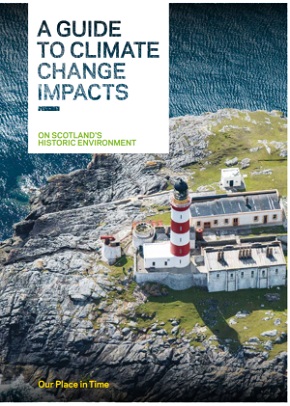New guide on managing climate change risk to Scottish historic sites

|
| A new guide to help Scotland’s historic sites adapt to the impacts of climate change has been published by Historic Environment Scotland (HES). |
Historic Environment Scotland (HES), as lead of the Our Place in Time (OPiT) Climate Change Working Group, brought together sector partners to launch the ‘Guide to Climate Change Impacts’ at Glasgow’s City Chambers.
The guide aims to raise awareness of the risks and hazards of climate change – such as increased rainfall, soaring temperatures, rising sea levels and shifting coasts – and their physical impact on the historic environment throughout Scotland. This information will empower owners and stewards of historic sites, as well as local communities, to help develop and implement adaptation measures to enhance resilience to climate change.
The guide identifies seven elements of the historic environment:
- Roofed buildings and infrastructure
- Gardens and designed landscapes
- Marine
- Coastal
- Surface remains
- Buried remains
- Collections and internal fabrics.
It explores the different hazards that threaten these sites. To help users assess risk, the guide also outlines the features that make a historic site more or less resilient to these impacts – for example, whether a building is in a good state of maintenance or repair.
The first of its kind, the guide has been produced collaboratively with partners from across the historic environment sector and beyond, including heritage trusts, tourist bodies, universities and religious organisations, as well as climate change specialists.
Hazel Johnson, OPiT Project Manager for built heritage and climate change at HES, said:
‘The rate of change to Scotland’s climate is already having profound impacts across all aspects of society, and poses real concerns for the future. Scotland’s historic environment is particularly vulnerable to the impacts of climate change, from sites in exposed coastal locations at risk from erosion, to stonework suffering accelerated decay caused by increasing rainfall.”
Ms Johnson continued: “But our historic places also offer a unique perspective on how humans have adapted to changes in their environment over hundreds and even thousands of years, and they have an important role to play in creating sustainable and resilient communities across the country. To achieve this, it’s essential we work together, and we’re pleased that this guide has been the product of real cross-sector collaboration, pooling and sharing experience and expertise from a range of organisations. The publication of the Guide to Climate Change Impacts is an important milestone for the historic environment sector in Scotland, and we look forward to seeing its use and development in the future.’
Ruth Wolstenholme, Managing Director of Sniffer, which delivers the Adaptation Scotland programme, said:
‘Adaptation Scotland welcomes the timely publication of this guide. We commend the extent to which it builds on a comprehensive understanding of the impacts of a changing climate and their significance for the historic environment. In setting out this information in a clear and systematic way, the guide has a vital role to play in raising awareness of climate change for all those involved in the sector.”
Ms Wolstenholme added: “Importantly, it also identifies adaptation responses without being prescriptive, encouraging decision makers to work together to manage Scotland’s heritage in ways that are most effective. This approach places the sector at the forefront as climate leaders and we hope it will inspire other sectors to produce similar joint resources.’
Read more and download the guide….
[edit] About this article
This article was written by Historic Environment Scotland (HES) and previously appeared on the website of IHBC in November 2019. It can be accessed HERE.
Articles by IHBC on Designing Buildings Wiki can be accessed HERE.
[edit] Related articles on Designing Buildings Wiki
- Caithness Broch Project.
- Conservation in the Highlands and Islands.
- Development of sustainable rural housing in the Scottish Highlands and Islands.
- Devolution.
- Engaging communities in our Highlands and Islands.
- Lord Leverhulme on Lewis and Harris.
- Macallan Distillery.
- Matthew Davidson stonemason and civil engineer.
- National planning policy framework.
- Orkney gables.
- Planning policy.
- Public authority.
- Re-thatching a Hebridean blackhouse.
- Scottish planning and architecture documents.
- The challenges and opportunities of conservation in the Highlands and Islands.
- The Engine Shed.
- Vernacular architecture.
IHBC NewsBlog
Old Sarum fire in listed (& disputed) WW1 Hangar - Wiltshire Council has sought legal advice after fire engulfed a listed First World War hangar that was embroiled in a lengthy planning dispute.
UK Antarctic Heritage Trust launches ‘Virtual Visit’ website area
The Trust calls on people to 'Immerse yourself in our heritage – Making Antarctica Accessible'
Southend Council pledge to force Kursaal owners to maintain building
The Council has pledged to use ‘every tool in the toolbox’ if urgent repairs are not carried out.
HE’s Research Magazine publishes a major study of the heritage of England’s suburbs
The article traces the long evolution of an internal programme to research 200 years of suburban growth
IHBC Context 183 Wellbeing and Heritage published
The issue explores issues at the intersection of heritage and wellbeing.
SAVE celebrates 50 years of campaigning 1975-2025
SAVE Britain’s Heritage has announced events across the country to celebrate bringing new life to remarkable buildings.
IHBC Annual School 2025 - Shrewsbury 12-14 June
Themed Heritage in Context – Value: Plan: Change, join in-person or online.
200th Anniversary Celebration of the Modern Railway Planned
The Stockton & Darlington Railway opened on September 27, 1825.
Competence Framework Launched for Sustainability in the Built Environment
The Construction Industry Council (CIC) and the Edge have jointly published the framework.
Historic England Launches Wellbeing Strategy for Heritage
Whether through visiting, volunteering, learning or creative practice, engaging with heritage can strengthen confidence, resilience, hope and social connections.














